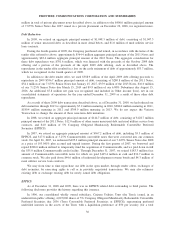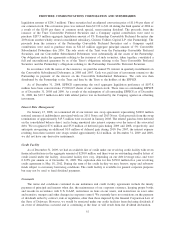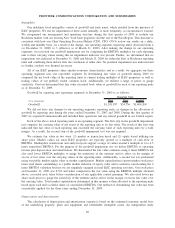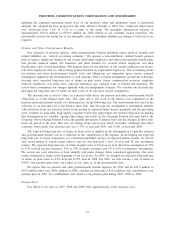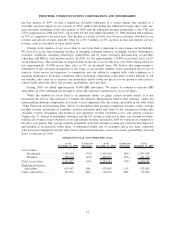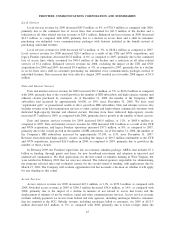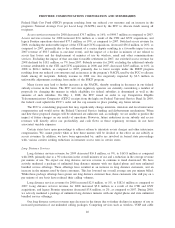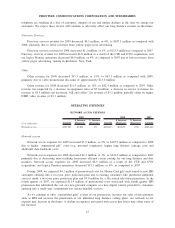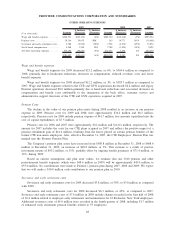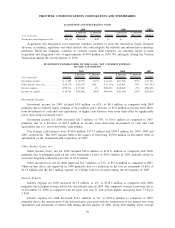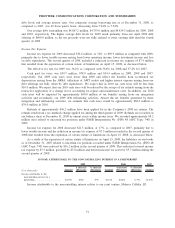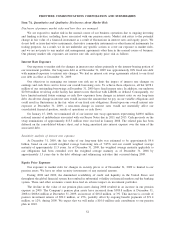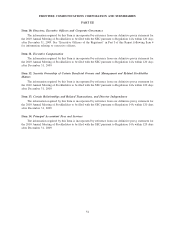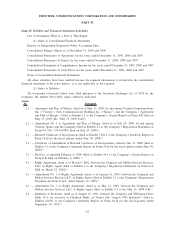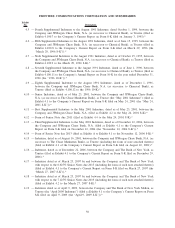Frontier Communications 2009 Annual Report Download - page 48
Download and view the complete annual report
Please find page 48 of the 2009 Frontier Communications annual report below. You can navigate through the pages in the report by either clicking on the pages listed below, or by using the keyword search tool below to find specific information within the annual report.Federal High Cost Fund (FHCF) program resulting from our reduced cost structure and an increase in the
program’s National Average Cost per Local Loop (NACPL) used by the FCC to allocate funds among all
recipients.
Access services revenue for 2008 decreased $74.7 million, or 16%, to $404.7 million as compared to 2007.
Access services revenue for 2008 increased $2.6 million as a result of the CTE and GVN acquisitions, and
legacy Frontier operations decreased $77.3 million, or 19%, as compared to 2007. Switched access revenue for
2008, excluding the unfavorable impact of the CTE and GVN acquisitions, decreased $56.8 million, or 20%, as
compared to 2007, primarily due to the settlement of a carrier dispute resulting in a favorable impact on our
2007 revenue of $38.7 million (a one-time event), and the impact of a decline in minutes of use related to
access line losses and the displacement of minutes of use by wireless, email and other communications
services. Excluding the impact of that one-time favorable settlement in 2007, our switched access revenue for
2008 declined by $18.1 million, or 7% from 2007. Subsidy revenue for 2008, excluding the additional subsidy
revenue attributable to the CTE and GVN acquisitions in 2008 and 2007, decreased $20.5 million, or 16%, in
2008 to $104.1 million, as compared to 2007, primarily due to lower receipts under the FHCF program
resulting from our reduced cost structure and an increase in the program’s NACPL used by the FCC to allocate
funds among all recipients. Subsidy revenue in 2008 was also negatively impacted by $2.5 million in
unfavorable adjustments resulting from audits of the FHCF program.
Many factors may lead to further increases in the NACPL, thereby resulting in decreases in our federal
subsidy revenue in the future. The FCC and state regulatory agencies are currently considering a number of
proposals for changing the manner in which eligibility for federal subsidies is determined as well as the
amounts of such subsidies. On May 1, 2008, the FCC issued an order to cap Competitive Eligible
Telecommunications Companies (CETC) receipts from the high cost Federal Universal Service Fund. In 2009,
the federal court upheld the FCC’s order and the cap remains in place pending any future reform.
The FCC is considering proposals that may significantly change interstate, intrastate and local intercarrier
compensation and would revise the Federal Universal Service funding and disbursement mechanisms. When
and how these proposed changes will be addressed are unknown and, accordingly, we are unable to predict the
impact of future changes on our results of operations. However, future reductions in our subsidy and access
revenues will directly affect our profitability and cash flows as those regulatory revenues do not have
associated variable expenses.
Certain states have open proceedings to address reform to intrastate access charges and other intercarrier
compensation. We cannot predict when or how these matters will be decided or the effect on our subsidy or
access revenues. In addition, we have been approached by, and/or are involved in formal state proceedings
with, various carriers seeking reductions in intrastate access rates in certain states.
Long Distance Services
Long distance services revenue for 2009 decreased $16.8 million, or 9%, to $165.8 million as compared
with 2008, primarily due to a 3% reduction in the overall minutes of use and a reduction in the average revenue
per minute of use. We expect our long distance services revenue to continue to trend downward. We have
actively marketed a package of unlimited long distance minutes with our digital phone and state unlimited
bundled service offerings. These offerings have resulted in an increase in long distance customers, and an
increase in the minutes used by these customers. This has lowered our overall average rate per minute billed.
While these package offerings have grown our long distance customer base, those customers who still pay on a
per minute of use basis have reduced their calling volumes.
Long distance services revenue for 2008 increased $2.0 million, or 1%, to $182.6 million as compared to
2007. Long distance services revenue for 2008 increased $5.8 million as a result of the CTE and GVN
acquisitions, and legacy Frontier operations decreased $3.8 million, or 2%, as compared to 2007. During 2008,
we actively marketed a package of unlimited long distance minutes with our digital phone and state unlimited
bundled service offerings.
Our long distance services revenue may decrease in the future due to further declines in minutes of use or
increased penetration of our unlimited calling packages. Competing services such as wireless, VOIP and cable
46
FRONTIER COMMUNICATIONS CORPORATION AND SUBSIDIARIES


